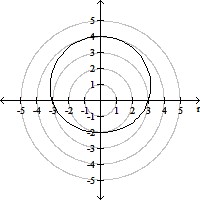Match the graph to one of the polar equations. 
A. r = 3 + sin ?
B. r = 3 + cos ?
C. r = 6 sin ?
D. r = 6 cos ?
Answer: A
You might also like to view...
Two sides and an angle (SSA) of a triangle are given. Determine whether the given measurements produce one triangle, two triangles, or no triangle at all. Solve each triangle that results. Round lengths to the nearest tenth and angle measures to the nearest degree.B = 13°, b = 7.1, a = 7.89
A. A = 166°, C = 1°, c = 0.6 B. A = 14°, C = 153°, c = 14.3 C. A1 = 14°, C1 = 153°, c1 = 14.3; A2 = 166°, C2 = 1°, c2 = 0.6 D. no triangle
Provide an appropriate response.Find all absorbing states for the transition matrix, and indicate whether or not the matrix is that of an absorbing Markov chain. 1 2 3 4 

A. State 2 and 3 are absorbing; the matrix is not an absorbing Markov chain. B. State 2 is an absorbing; the matrix is not an absorbing Markov chain. C. State 2 is an absorbing; the matrix is an absorbing Markov chain. D. State 2 and 3 are absorbing; the matrix is an absorbing Markov chain.
Write an equation that expresses the relationship. Use k for the constant of proportionality.P varies jointly as R and S and inversely as the square root of a.
A. P = 
B. P = 
C. P = 
D. P = 
Translate to an inequality.The perimeter is greater than 249.
A. x ? 249 B. x > 249 C. x ? 249 D. x < 249